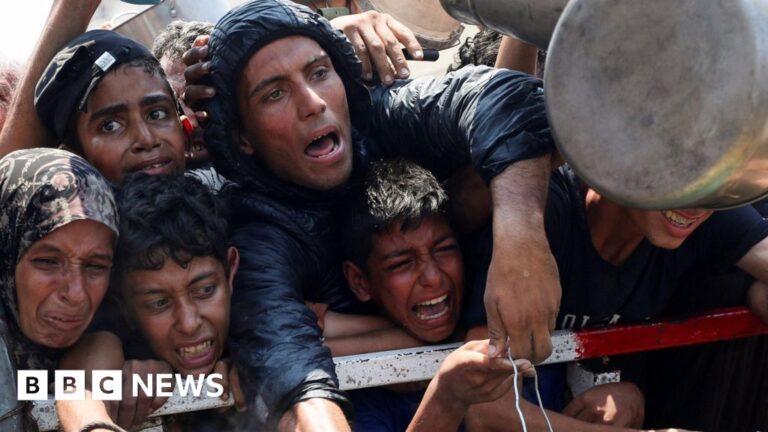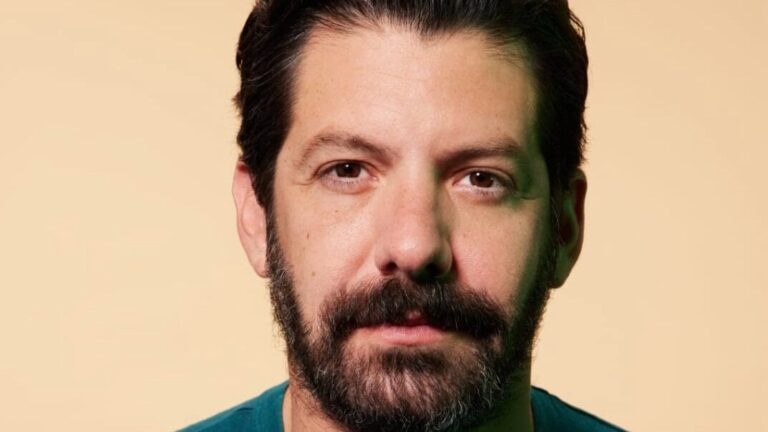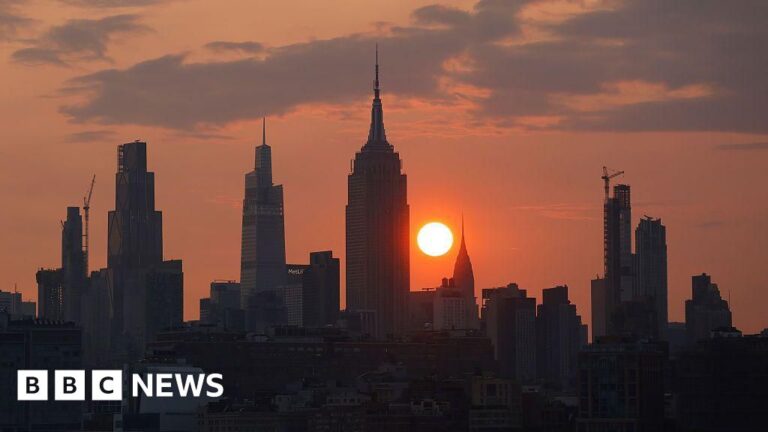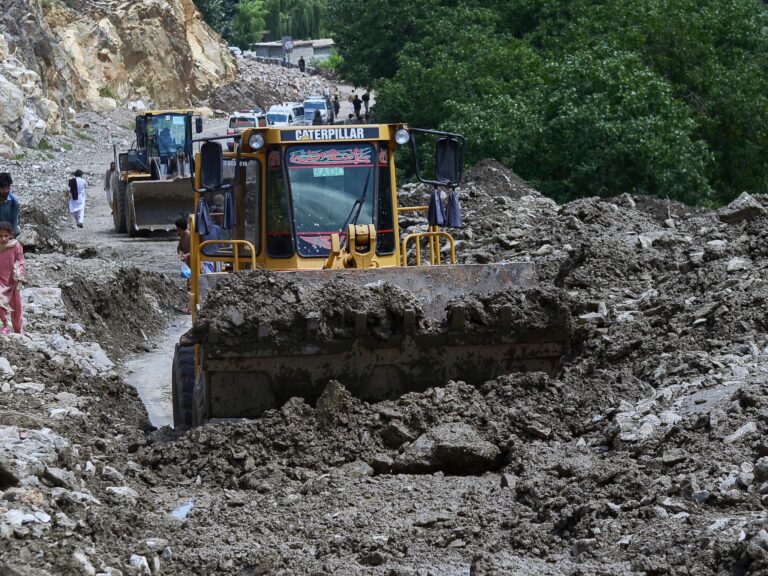Tesla updates robotaxi users about chauffeur-style service in California, Business Insider reports
Israel to Establish Humanitarian Corridors in Gaza as Aid Deliveries Commence
Israel has said it is prepared to open humanitarian corridors to allow UN convoys into Gaza, following weeks of international pressure and a growing hunger crisis.
In a statement on Saturday, the Israel Defense Forces (IDF) said it had allowed air drops of humanitarian aid to resume, the first of which consisted of seven pallets of flour, sugar and canned food provided by international organisations.
The announcement came amid calls for Israel to let more aid into Gaza and amid warnings of mass starvation following months of limited supply to the territory’s two million people.
Israel denied what it called “the false claim of deliberate starvation in the Gaza Strip”.
The IDF said it had “begun a series of actions aimed at improving the humanitarian response in the Gaza Strip”, and was “prepared to implement humanitarian pauses in densely populated areas”.
It also stated that it had resumed supplying power to a desalination plant in Gaza, which it said would “serve about 900,000 residents”.
Reuters late on Saturday reported Palestinian sources as confirming air drops had resumed in northern Gaza.
Israel cut off all supplies to Gaza from the start of March, and resumed with new restrictions in May.
Along with the US, it backed the Gaza Humanitarian Foundation (GHF) and allowed it to operate in Gaza.
There have been almost daily reports of Palestinians being killed while seeking aid since the GHF began operations in late May. Witnesses have told the BBC most have been shot by Israeli forces. Israel has said that its troops fire warning shots and has disputed reported death tolls. It accuses Hamas of instigating chaos near the aid points.
The UN, aid groups and some of Israel’s allies have blamed the country for a growing food crisis in Gaza, and called for the unrestricted entry and delivery of aid as the Hamas-run health ministry said dozens of people were dying from malnutrition. On Saturday it put the toll from the last few days at 125, including 85 children.
The World Health Organization (WHO) chief, Tedros Adhanom Ghebreyesus, described the crisis as “man-made mass starvation”.
The IDF said in its statement that responsibility for food distribution to the population in Gaza “lies with the UN and international aid organisations” and added they must “ensure that the aid does not reach Hamas”.
Israel’s apparent concessions on Saturday followed its acceptance of a Jordanian and UAE plan, backed by the UK, to air drop aid into Gaza. Aid agencies however said such would do little to mitigate the hunger of Gazans.
The head of the UN’s Palestinian refugee agency Unrwa, Philippe Lazzarini, said air drops were “expensive, inefficient, and can even kill starving civilians” if they did not go according to plan.
Lazzarini said his organisation had “the equivalent of 6,000 trucks” in Jordan and Egypt waiting to enter Gaza, and urged Israel “lift the siege, open the gates and guarantee safe movements and dignified access to people in need”.
The BBC spoke to several Gazans on Saturday who worried air drops could cause “serious harm”.
One man living in the north of the strip told BBC Arabic’s Middle East Daily that the process was “unsafe” and “caused numerous tragedies” when similar relief efforts were attempted last year.
“When aid is dropped from the air, it risks landing directly on tents, potentially causing serious harm, including injury or even death,” he said.
Meanwhile, Palestinians are battling dehydration along with starvation. One mother told the BBC she was “living with no food or drink, no food, no bread, not even water.”
Israel launched a war in Gaza in response to the Hamas-led attack on southern Israel on 7 October 2023, in which about 1,200 people were killed and 251 others were taken hostage.
More than 59,000 people have been killed in Gaza since then, according to the Hamas-run health ministry.
Health and Technology Officials in the US Set to Introduce Data-Sharing Strategy
Top Trump administration health officials are expected to bring tech companies to the White House this week to roll out a plan to encourage more seamless sharing of health-care data, according to people familiar with the matter.
Health and Human Services Secretary Robert F. Kennedy Jr. and Centers for Medicare and Medicaid Services Administrator Mehmet Oz are expected to host executives at an event on Wednesday, said the people, who did not provide names of the attendees and asked not to be named because the details haven’t been made public.
The plan was developed in coordination with the White House, building on a May effort by CMS to get public input on addressing barriers to sharing patient data.
The initiative was led by Amy Gleason, acting administrator of DOGE, the initiative known as Department of Government Efficiency, and Arda Kara, a senior adviser at CMS. Both worked for health-tech startups before joining the Trump administration.
“This initiative aims to build a smarter, more secure, and more personalized health care system — one that improves patient outcomes, reduces provider burden, and drives greater value through private-sector innovation and aligned federal leadership,” CMS spokesperson Catherine Howden said in a written statement.
Clear, a company known for its identity verification services frequently used within airports, is planning to attend, according to people familiar with the matter. The company has previously targeted the healthcare industry for expansion. A company spokesperson declined to comment.
Companies will commit to a voluntary framework around what’s known as interoperability, or how different health technology systems connect to one another and share data, the people said. Improving the flow of data across the fragmented US health-care system has long been a policy goal of both Democratic and Republican administrations seeking to improve quality and reduce waste.
The pledges will involve principles around patient and provider access to health information, and data sharing standards, among other elements. CMS will share additional information next week about the timeline for the plan, Howden said.
Paramilitary-Led RSF Coalition Establishes Parallel Government in Conflict-Ridden Sudan | Latest Sudan War Updates
As violence and rights abuses rage on, the coalition pledges to pursue a ‘secular, democratic’ and decentralised Sudan.
A Sudanese coalition led by the Rapid Support Forces (RSF) paramilitary group has announced it is establishing an alternative government in a challenge to the military-led authorities in the capital Khartoum, with the northeastern African country’s brutal civil war in its third year.
The group, which calls itself the Leadership Council of the Sudan Founding Alliance (TASIS), said RSF leader Mohamed Hamdan “Hemedti” Dagalo will chair the 15-member presidential council of the government, which includes regional governors.
Sudanese politician Mohammed Hassan Osman al-Ta’ishi will serve as prime minister, TASIS said.
“On the occasion of this historic achievement, the leadership council extends its greetings and congratulations to the Sudanese people who have endured the flames of devastating wars for decades,” the coalition said in a statement.
“It also renews TASIS’s commitment to building an inclusive homeland, and a new secular, democratic, decentralized, and voluntarily unified Sudan, founded on the principles of freedom, justice and equality.”
The new self-proclaimed government could deepen divisions and lead to competing institutions as the war rages on between the RSF and the Sudanese Armed Forces (SAF).
In May, the Sudanese army said it had completely driven the RSF out of the capital, Khartoum.
The fighting since April 2023 has killed tens of thousands and displaced nearly 13 million people, according to United Nations estimates, resulting in one of the worst humanitarian crises in the world.
In recent months, the violence has been intensifying in the western region of Darfur, where the RSF has been besieging the city of el-Fasher, compounding hunger in the area.
Rights groups have accused both the RSF and SAF of rights abuses. Earlier this year, Amnesty International said RSF fighters were inflicting “widespread sexual violence” on women and girls to “assert control and displace communities across the country”.
Earlier this year, the US imposed sanctions on Hemedti, accusing the RSF of committing “serious human rights abuses” under his leadership, including executing civilians and blocking humanitarian aid.
Sudan has seen growing instability since longtime President Omar al-Bashir was removed from power in 2019 after months of antigovernment protests.
In October 2021, the Sudanese military staged a coup against the civilian government of Prime Minister Abdalla Hamdok, leading to his resignation in early 2022.
Sudan’s army chief, Abdel Fattah al-Burhan and Hemedti had shared power after the coup, but then began fighting for control of the state and its resources in April 2023.
Although the rivalry between al-Burhan and Hemedti does not appear to be ideological, numerous attempts to reach a peaceful resolution to the crisis have failed.
Jérémy Erlich, Former Spotify Executive, Introduces ALTA Music and Signs K-pop Sensation JENNIE
Jérémy Erlich, who left Spotify in February after serving as its Global Head of Music, has launched an independent, full-service music company called ALTA Music Group with Korean pop star JENNIE as its first major signing.
The Los Angeles-based company will operate across recorded music, music publishing and artist management services.
ALTA Music has secured distribution through The Orchard, Sony Music‘s independent distribution arm, and struck a partnership with THEBLACKLABEL, the Seoul-based label founded by producer Teddy Park, known for his work with BLACKPINK and other K-pop acts.
BLACKPINK’s JENNIE, who released her debut album, RUBY, in March, joins ALTA’s talent management roster alongside her existing partnership with OddAtelier.
Notably in January last year, BLACKPINK members including JENNIE ended their solo contracts with YG Entertainment.
In addition to JENNIE, ALTA also signed Cat Matthews, New York group WHATMORE, and rapper Bodhi Bleu for its recorded music and publishing divisions.
Erlich founded ALTA after spending almost six years at Spotify. There, he helped the platform nearly triple in size from 230 million monthly active users (MAUs) to over 670 million MAus and 275 million subscribers. Before joining Spotify in 2019, he spent eight years between Universal Music Group and Interscope Geffen A&M.
“Throughout my career I’ve focused on the best way to service artists around the world that would create an environment that sets them up for long-term, global success. With ALTA we have the opportunity to do just that.”
Jérémy Erlich, ALTA Music
Brad Navin, CEO of The Orchard, said: “Jérémy’s decision to launch ALTA Music Group is a testament to his entrepreneurial spirit, deep understanding of the global music landscape, and commitment to artist development.”
“His artist-first philosophy aligns with The Orchard’s mission to empower creators. We are proud to partner with ALTA, leveraging our global distribution network and comprehensive suite of services to help their roster reach worldwide audiences and open new avenues for success.”
Erlich added: “Throughout my career I’ve focused on the best way to service artists around the world that would create an environment that sets them up for long-term, global success. With ALTA we have the opportunity to do just that – a best in class team focused solely on supporting our artists and the music they create. Everything else does not matter. I’m grateful to the artists and executives who have already put their trust in me and our company.”
“Jérémy’s decision to launch ALTA Music Group is a testament to his entrepreneurial spirit, deep understanding of the global music landscape, and commitment to artist development.”
Brad Navin, The Orchard
ALTA’s leadership team includes Nima Khalilian, who previously led international operations at music distribution and payments platform, Stem. Khalilian also served as senior director of international marketing at Interscope Records, working with artists including Gracie Abrams, Karol G, as well as Interscope Capitol Label Group’s Yo Gotti, GloRilla and Moneybagg Yo, among others.
Khalilian said: “ALTA is about putting artists first and helping them navigate an ever-evolving industry with a clear strategy. I’m honored to work alongside Jérémy to build a company that prioritizes our artist’s creativity and global impact. We want to be the best possible partners for artists in order for them to build a lasting legacy.”
Joining Erlich and Khalilian are Parker Ulry, Drake Hofer, Elise Eriksen, Gillian Taugher and Michael Seltzer.
Ulry held roles at Interscope Records and led digital marketing for artists including DaBaby, Summer Walker, blackbear, ScHoolboy Q, and Eminem, among others, at Warner Records.
Seltzer, meanwhile, previously served as EVP of Business & Legal Affairs and Head of Commercial Transactions, UMG, leading teams that facilitated the company’s agreements including recording contracts, label ventures, label distribution, merchandise, vendors, trademark entities, brand partners, film/TV/theatrical productions, equity and asset acquisitions, and more.
Music Business Worldwide
New York air quality alert issued due to Canadian wildfires
An air quality health advisory has been issued for New York City and its surrounding areas because of smoke from wildfires in Canada.
In a post on X, New York state’s Department of Environmental Conservation (DEC) and Department of Health (DOH) issued the advisory for Long Island, New York City Metro, Lower Hudson Valley, Upper Hudson Valley, and the Adirondacks on Saturday.
Authorities are warning air quality in those regions is “unhealthy for sensitive groups”.
Wildfires in Canada have forced tens of thousands of people to leave their homes, and the smoke drifting over the border has sparked air quality concerns across the northern United States.
The air quality index (AQI) is predicted to be above 100 in much of New York state on Saturday, and could reach 135. Alerts are also in place for parts of New England.
The AQI measures the severity of pollution in the air and categorises health risks. The higher the number, the more unsafe the air is to breathe.
This is not the first time US authorities have issued air quality alerts because of smoke from the Canadian wildfires.
In mid-July, a similar alert was issued for Chicago, with additional precautions advised for babies and the elderly.
The political implications of the wildfire smoke have also reached Washington.
Earlier in July, six members of Congress wrote to the Canadian ambassador complaining that smoke from wildfires was making it difficult for Americans to enjoy their summer.
There are currently more than 550 active fires in Canada, with the most concentrated in the province of Manitoba, according to authorities. 6.1 million hectares (15 million acres) of land has been burnt across the country in the past year.
May and June were particularly destructive months in western Canada, with roughly 30,000 people forced to evacuate in the provinces of Saskatchewan and Manitoba, where local administrations declared a state of emergency.
Scientists have consistently linked the intensifying wildfire seasons to climate change.
Canada is believed to be warming at twice the global average rate, and its Arctic regions are heating up at nearly three times the global rate, scientists have warned.
Preview of the 2025 World Championships: Hubert Kos Maintains Lead Against American Duo in Men’s 200 Backstroke
By Madeline Folsom on SwimSwam

2025 World Championships
- July 27 – August 3, 2025 (pool swimming)
- Singapore, Singapore
- World Aquatics Championships Arena
- LCM (50m)
- Meet Central
- Entry Book
- Live Results
- SwimSwam Preview Index
Men’s 200 Backstroke: By the Numbers
- World Record: 1:51.92– Aaron Peirsol, United States (2009)
- World Junior Record: 1:55.14– Kliment Kolesnikov, Russia (2017
- World Championships Record: 1:51.92– Aaron Peirsol, United States (2009)
- 2023 World Champion: Hubert Kos (HUN)- 1:54.14
- 2024 Olympic Champion: Hubert Kos (HUN)- 1:54.26
Returning Olympic Finalists: Gold- Hubert Kos (Hungary), Bronze- Roman Mityukov (SUI), 4th- Keaton Jones (USA), 7th- Pieter Coetze (RSA), 8th- Lukas Märtens (GER)
The men’s 200 backstroke is one of the closest 200 races, based purely on times, at these World Championships. The top five seeds in the event fall within six tenths of one another from 1:54.25 to 1:54.85.
The same is true for the collection of athletes from 6th-11th with seed times from 1:55.39-1:55.97. We could be looking at not only an exciting race for the podium, but also for finals places.
The Champion
Hubert Kos from Hungary is coming into the meet as the reigning Olympic Champion and the 2023 World Champion, but he is the 2nd seed in the event behind American Jack Aikins.
Kos swam 1:54.26 in Paris to win the gold by just over half-a-second. This time was just over a tenth off his lifetime best of 1:54.14 that he swam to win the event at the 2023 Worlds.

Hubert Kos (photo: Jack Spitser)
His fastest time this season comes from the 1:55.50 he set at the Longhorn Elite Invite in May which has him sitting in 5th in the World this year, but, as mentioned above, he is the 2nd seed with the time he swam in Paris, just one-hundredth behind the time that the American Aikins swam at US Nationals.
Kos has had an excellent year, winning the 200 backstroke at the 2024 SC World Championships in 1:45.65, just two-hundredths off the World Record of 1:45.63. He then won the 200 back at the 2025 men’s NCAA Championships in 1:34.21, dropping more than a second from his preseason best time of 1:35.69. He has already been about half-a-second faster this year than he was at this point last year, when he went into the Olympics with a season best 1:55.95.
I don’t think it would be out of the question for Kos to drop into the 1:53 range for the first time this week, especially with everyone chasing him for the gold.
‘54 Club
After Kos, there are a few athletes who will not only be battling for spots on the podium, but also looking to upset the favorite for the gold.
Leading that charge is the American Aikins, who is coming in seeded ahead of Kos with his U.S. Nationals time of 1:54.25.
This was a massive breakout swim for him, dropping more than half-a-second from the 1:54.78 he swam to finish 3rd at last summer’s Olympic Trials. It also marked only the 2nd time he has ever been 1:54 in the event, and if he can replicate that swim he would be a strong contender for the podium.

Jack Aikins (photo: Jack Spitser)
There are a few factors impacting his potential in the event, one of which is the fact that we have not seen him execute the double taper yet. He has swum at two World Championships, the 2024 long course meet in Doha and the 2024 SC Worlds in Budapest, but neither of these meets required a qualifying meet in the month before. He does have experience swimming in the NCAA and competing at conference and then the NCAA Championships, but that is a slightly different situation.
This question is even more impacted by the reports about the American swimmers with food poisoning. If he is one of the affected athletes, it could make this schedule even harder, but the 200 backstroke is later in the meet, so he will have more time to recover if he needs it.
After Aikins and Kos, we have another American as the 4th seed, Keaton Jones. Jones was one of the two United States athletes in the 200 backstroke in Paris, and he was the only one to final, ultimately finishing just outside of medal position in 4th. He is seeded with the 1:54.61 he swam at the U.S. Olympic Trials last summer, but he hasn’t been too far off that this year, swimming 1:54.85 at Nationals to be 3rd in the world.
Jones, who could also be impacted by the American food poisoning issues, was off his times at the Olympics last summer, ultimately swimming 1:55.39 in the final. One of the things that is going for him, though, is that he did not seem to be affected by the semifinals schedule, getting faster by about a second in each iteration from the prelims to finals. He is a solid finals contender, and could end up on the podium with the right swim.
The 4th seed sits just behind Jones with a seed time of 1:54.66. Greek swimmer Apostolos Siskos has taken the place of his fellow Greek athlete and Olympic silver medalist, with whom he shares a first name, Apostolos Christou who is only swimming the 50 and 100 backstroke events next week. Siskos has slotted into the event nicely, however, coming in with the 2nd fastest time in the world this year from Greek Nationals.
Siskos was 14th in the semifinals last summer, but he will be looking to move up those rankings significantly, and he is poised to do so, having already dropped almost eight tenths from his previous best time of 1:55.42 from the 2024 Euros.
The final member of our 54 club is Olympic bronze medalist from Switzerland Roman Mityukov who is seeded with the 1:54.85 he swam in Paris to set the Swiss National Record.

World Aquatics Championships – Doha 2024
02 – 18 Feb 2024
Credit Fabio Cetti
Mityukov, who also won the silver medal at the 2024 World Championships has a season best time of 1:55.64, which he swam at the Swiss Swimming Championships in April. This is just four-hundredths off the 1:55.60 he swam at the 2024 Swiss Nationals, which is a good sign for another 1:54 swim to potentially end up on the podium.
The Chase Pack
Behind the top five seeds, there are six athletes who are seeded with 1:55s, and there are some big names among them.
Jumping around a little bit, at 11th seed, we have 400 freestyle World Record holder Lukas Märtens from Germany. Märtens was 8th at the Olympics in 1:55.97, which is his lifetime best and the time he is seeded with in Singapore. The biggest factor going for him in this race is the fact that he scratched out of the 200 freestyle in order to focus on his other events, including the 200 backstroke.
Märtens has some work to do if he wants to qualify for the final, however, as 1:55.9 is probably not going to do it. His season best time is just off, though, at 1:56.00 which he swam at the German Swimming Championships in May. If he is able to drop half-a-second, he could find his way into the final.
There is a 2nd World Record holder in the event, this time in the 100 backstroke, in Italy’s Thomas Ceccon who is the 9th seed. Ceccon did not qualify for the final in Paris, finishing 9th in 1:56.59. He has been significantly faster than that mark this season, coming in at 1:55.71 from the Australian Open in April. This was a new lifetime best for him, but he has changed up his training this year, swimming with Dean Boxall in Australia, and we know he has the speed thanks to his World Record. This makes him an interesting bet for the final.

Pieter Coetze (photo: Jack Spitser)
Jumping up one spot from Ceccon, we have South African swimmer Pieter Coetze, who just made headlines for his incredible 100 backstroke at the World University Games where he set a new world leading time. He did not swim the 200 backstroke at that meet, but he finished 7th at the Olympics last summer in 1:55.60, his seed time. If his 100 backstroke is any indication about what we can expect to see, he could drop a monster swim here. He is coming off the WUGs, though, and with how late in the meet the 200 backstroke is, we have no idea if he will still be in top form by the time the final happens.
Oleksandr Zheltiakov from Ukraine, Ollie Morgan from Great Britain, and Dmitry Savenko from Russia/NAB make up the other three athletes seeded in the 1:55 range. Zheltiakov is seeded in 1:55.39 which he swam last June, and he is the top seeded 1:55 swimmer. He had a disappointing Olympics, touching in 1:58.41 to finish 20th, missing the final entirely, but if he repeats the 1:55.39 performance, he could easily make the final. His season best stands at 1:57.34 from June.
Morgan sits in 6th in the world this year in 1:55.55, which he swam at the British Swimming Championships in April, and he is the 7th seed in Singapore. Morgan finished 12th in the semifinal in Paris, touching in 1:57.28.
Dmitry Savenko is seeded with 1:55.91, just six-hundredths ahead of Märtens . He swam this time at the Russian Championships in April, but has been as fast as 1:55.60, which he swam at last year’s Russian Championships. He has not competed at any recent international long course meets due to the sanctions placed on Russia, but at the SC Worlds, he finished 7th in the 200 backstroke.
Japan’s Hidekazu Takehara is not technically seeded under 1:56, but he has been 1:55 this year, swimming 1:55.79 at the Tokyo Championships in June. He is seeded with the 1:56.11 he swam in March, and he finished 16th at the Games last summer, but if he stays in that 1:55 range or drops even more, he will be in contention for the final.
The Picks
Hubert Kos has been incredibly strong in this event over the last few years, and we aren’t betting against him this year either. He is the favorite to win, but there are a number of athletes waiting in the wings for a mistake.
The Americans are solid contenders for medals, but with unclear information about which athletes have been impacted by food poisoning, it is difficult to accurately predict who will be where.
At the bottom of the final, we have any number of athletes that could make it, but Märtens and Coetze are having exceptional years, and that gives them the edge in a field that is incredibly close.
| Place | Swimmer | Country | Season Best | Lifetime Best |
| 1 | Hubert Kos | Hungary | 1:55.50 | 1:54.14 |
| 2 | Jack Aikins | United States | 1:54.25 | 1:54.25 |
| 3 | Keaton Jones | United States | 1:54.85 | 1:54.61 |
| 4 | Roman Mityukov | Switzerland | 1:55.64 | 1:54.85 |
| 5 | Apostolos Siskos | Greece | 1:54.66 | 1:54.66 |
| 6 | Thomas Ceccon | Italy | 1:55.71 | 1:55.71 |
| 7 | Pieter Coetze | South Africa | 1:56.07 | 1:55.60 |
| 8 | Lukas Märtens | Germany | 1:56.00 | 1:55.97 |
Dark Horse: Yohann Ndoye-Brouard (France)– Ndoye-Brouard is the 16th seed with the 1:56.38 he went towards the end of June this year, but he has a lifetime best of 1:55.62 from August of 2022. His time in June was faster than he has been since 2023, and he has had strong swims in the 50 and 100 backstrokes this year which is a good sign for his potential to drop back into the 1:55 range and earn his way into the final.
Read the full story on SwimSwam: 2025 World Championships Previews: Hubert Kos Holding Off American Duo in Men’s 200 Backstroke
Challenging Client
A required part of this site couldn’t load. This may be due to a browser
extension, network issues, or browser settings. Please check your
connection, disable any ad blockers, or try using a different browser.
3D-Printed Salmon Fillet Sets the Stage for Printing Meat and Fish Meat and Fish Printing Revolution Begins with 3D-Printed Salmon Fillet 3D-Printed Salmon Fillet: A Giant Leap for Meat and Fish Printing Technology
There have been studies indicating a potential collapse of fishing grounds by 2050. It is projected that by the same year, the amount of plastic in the sea may surpass the fish population. However, the concerning reality is already apparent: around 80% of fishing grounds have hit their exploitation limit or are overexploited. Aquaculture presents its own challenges as fish protein is utilized for fish farm feed. Given this grim outlook, breakthroughs in science and technology are imperative to present dietary alternatives.
Similar to discussions around lab-grown meat, meat, and fish printers are gaining traction as a potential solution to nourish our population in the upcoming decades. For instance, a notable development is the recent commercialization of a 3D-printed salmon fillet.
A fish printer for the menu of the future
Before moving forward, it’s important to clarify that the new salmon-like preparation isn’t derived from actual fish but is crafted using mycoproteins sourced from fungal filaments, providing it with a meaty texture. We’ve previously discussed the diverse applications of fungi and their mycelium, ranging from construction and furniture manufacturing to pollution-fighting tiles on building exteriors. However, their utilization in food printing is a relatively recent development.
The Austrian company responsible for the vegan salmon fillet asserts that, in addition to mushroom filaments, they’ve incorporated twelve other ingredients, including pea protein, plant oils, and algae extracts. The outcome is a protein and Omega-3-rich food akin to its genuine fish counterpart. A notable advantage of this 3D-printed fillet is its longevity, remaining fresh for up to three weeks.
While we often discuss prototypes and emerging technologies in testing phases, the recently unveiled 3D-printed “salmon-inspired” fillet is now commercially available in Europe. Its creators contend that this food technology is ready for industrial production and will represent the vanguard of various foods born from 3D printers in a future characterized by population growth and resource limitations.
While we often discuss prototypes and emerging technologies in testing phases, the recently unveiled 3D-printed “salmon-inspired” steak is now commercially available in Europe. Its creators contend that this food technology is ready for industrial production and will represent the vanguard of various foods born from 3D printers in a future characterized by population growth and resource limitations.
3D-printed calamari rings
Vegan meat and fish printing technology is incredibly versatile, expanding its horizons beyond salmon fillets to include experiments with shrimp and calamari rings. One such pioneering effort is led by a team of researchers in Singapore, who’ve harnessed green soy and microalgae proteins to replicate the texture, flavor, and elasticity of cephalopod rings.
The inaugural rendition of the 3D-printed squid rings was unveiled in August 2023 during a gathering of the American Chemical Society. Employing a food 3D printer, this innovative system relies on edible inks capable of mimicking various textures, be they greasy or fibrous. The distinct marine flavor is attributed to the microalgae used, offering both umami and a maritime aftertaste.
While a battered version of the squid rings has not been unveiled yet, the researchers have successfully passed the culinary test by frying their creation in an air fryer. Their ongoing mission is to enhance the elasticity and texture of their vegan squid before it hits the commercial market. You can observe a portion of their process in the following video:
@hashem.alghaili Scientists created 3D-printed calamari. #Research #Food #Biotechnology ♬ original sound – Hashem Al-Ghaili
It’s important to note that meat and fish printing isn’t inherently sustainable; its ecological footprint largely hinges on the choice of raw materials. In the case of squid rings, the green soybeans used are sourced from Asian food industry waste, as the vegetable’s starch is typically utilized in crystal noodles. For those interested in exploring alternative food solutions driven by cutting-edge technologies, we recommend reading this article on synthetic proteins crafted from water, electricity, and air.
Source:
Pakistan warns of glacial floods in northwest region, predicts heavy rainfall | Climate Crisis Update
Areas affected include popular tourist destinations, such as Fairy Meadows, Khyber Pakhtunkhwa and Gilgit-Baltistan.
Pakistan has issued a warning about glacial flooding in the northwest with more rain forecast in the coming week, as the country experiences above-average rainfall this monsoon season and continues to struggle to recover from devastating floods in 2022.
Downpours are heavier in the Khyber Pakhtunkhwa province than the same period last year, prompting weather advisories and alerts for flooding from glacial lake outbursts, said Anwar Shahzad, a spokesperson for the local disaster management authority, on Saturday.
The weather advisory alert comes after the authority sent out a letter earlier this month saying “persistent high temperatures may accelerate snow and glacier melt and subsequent weather events” in vulnerable parts of the region, underscoring the ongoing heavy impact of climate change on the country.
Spokesperson Faizullah Firaq said on Saturday there was “severe destruction” in some areas and damage to houses, infrastructure, crops, and businesses.
Search operations were under way to find missing people on the Babusar Highway, where flooding struck nine villages. Helicopters rescued tourists stuck in the popular spot, Fairy Meadows, he added.
Abdul Samad, from the Khyber Pakhtunkhwa Tourism Department, said rescue teams evacuated more than 500 holidaymakers from Naran after a cloudburst overnight Friday caused a road closure. Authorities deployed heavy machinery to remove debris and restore access.
In the neighbouring Gilgit-Baltistan region, the government said it had distributed hundreds of tents, thousands of food packets, and medicine to flood-affected communities. Three people died there on Tuesday when a cloudburst caused floods and landslides, stranding more than 200 tourists who were later rescued.
Zakir Hussein, director general of Gilgit-Baltistan’s Disaster Management Authority, said on Tuesday that while warnings help reduce the presence of tourists in these vulnerable areas, they are not always enough.
“Generally, tourists pay attention to our warning notices. Those who still choose to come are either those who did not see the warning or those who have some urgency to visit,” Hussein told Al Jazeera. “At the end of the day, it is weather prediction, but considering the severity of the consequences, people should take it seriously.”
The rains are a routine part of South Asia’s climate and are essential for crop irrigation and replenishing water supplies.
However, their adverse effect has worsened in recent years due to rapid urban expansion, poor drainage systems, and more frequent extreme weather events linked to climate change.
Pakistan’s above-average rainfall this monsoon season has raised concerns of a repeat of the devastating 2022 floods that submerged a third of the country, killed 1,737 people and displaced more than 30 million. Some 260 have died across Pakistan so far this season, which runs through to mid-September.
Pakistan, which has a population of about 250 million, is one of the world’s most vulnerable countries to climate change, but one of the lowest contributors to greenhouse gas emissions. It is also home to more than 7,000 glaciers – the largest outside the Earth’s polar regions.










